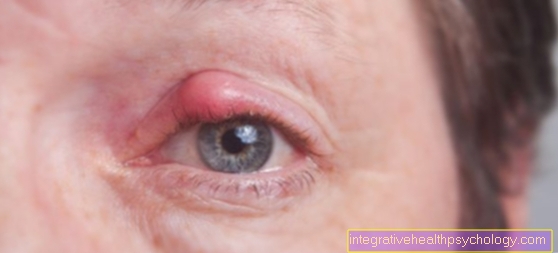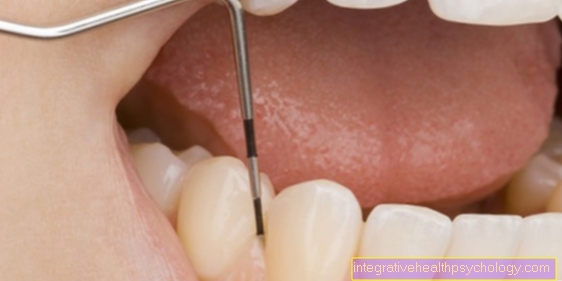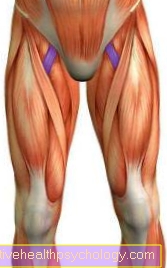Iliopsoas muscle
Synonyms
German: Lumbar and iliac muscles
- to the thigh muscles overview
- to the musculature overview
introduction

The iliopsoas muscle (lumbar iliac muscle is a two-part, approximately 4 cm thick, elongated muscle consisting of the large lumbar muscle and the iliac muscle. It is one of the most important muscles in our body.
Approach, origin, innervation
Approach: Small rolling mound (Lesser trochanter)
Origin: 12th thoracic vertebrae, 1st - 4th lumbar vertebrae (Processus costarii)
Innervation: Femoral nerve, Th 12 - L5
Illustration iliopsoas muscle

Iliopsoas muscle
(Iliac - lumbar - muscle)
- Lumbar muscle -
Psoas major muscle - Iliac muscle -
Iliacus muscle - Great Rolling Hill -
Greater trochanter - Small rolling hill -
Lesser trochanter - Pubic bone - Pubis
- Iliac scoop -
Ala ossis ilii - Thigh shaft -
Corpus femoris - Iliac crest -
Iliac crest - First lumbar vertebra -
Vertebra lumbalis I - Fifth lumbar vertebra -
Vertebra lumbalis V - Lumbar and sacrum kink -
Promontory
You can find an overview of all Dr-Gumpert images at: medical illustrations
How is the muscle trained / contracted?
In order to train the iliopsas, there must be a flexion in the hip joint. There is no special device for this muscle group, so a form of exercise with the expander is particularly suitable.
The athlete stands upright and fixes the expander on the ankle and behind the body. Now there is a movement that is similar to climbing stairs. The foot is lifted forwards and upwards. The continuous increase in the expansion of the expander stresses the muscles progressively.
Another unwanted contraction occurs if the abdominal cruch is incorrectly executed and the feet are fixed during execution.
For more information, see Weight Training
How is the iliopsoas muscle stretched?

Especially for people who regularly and intensely Doing sport is extremely important to the M. Iliopsoas before every training session extensively to those. This is the only way to prevent overloading the muscle fibers and tendons. Stretching is also the most important measure in the Prevention of the so-called iliopsoas syndrome.
In order to effectively stretch the muscle the athlete should stand upright aligning both knees approximately parallel to each other. The foot of the leg to be stretched should be pulled towards the buttocks. In this way, the Iliopsoas muscle is stretched. However, the stretching can do this reinforced be that the athlete the Hip forward pushes. The effectiveness of the exercise can also be increased by aligning the thigh to be stretched backwards.
In addition, there is another exercise that can help effectively stretch the iliopsoas muscle (see illustration). At the beginning of this exercise, the athlete goes into a pronounced step position. The thigh to be stretched should be in Shifted towards the ground become. At the same time, the athlete should make an effort Gently push your hips forward. If this exercise is performed correctly, you should clearly feel the stretching of the iliopsoas muscle.
function
The iliopsaos muscle acts as an antagonist of the Abdominal muscles and glutes and is the strongest flexor in the hip joint. He is responsible for straightening the upper body in the supine position (throw-in in football).
The iliopsos muscle is the most important muscle in running, walking and jumping in that it brings the leg forward, up and out. If this muscle fails, the ligament tensioner, the straight thigh muscle and the Tailor muscle the function of diffraction take over in the hip joint. This muscle is atrophied, especially in older people. The consequences are often difficult climbing stairs and problems walking.
Iliopsoas Syndrome
The one under the name "M. iliopsoas syndrome " known disease is based on both one Shortening of the actual muscle, as well as on one Inflammation of the bursae located under the iliopsoas tendon. Excessive stretching of the shortened muscle parts can cause the muscle fibers or the tendon come.
causes
The most common causes of M. iliopsoas syndrome include themselves repetitive, powerful movements of Hip joint. Even short, reflexively executed movement patterns can be one Tear of the iliopsoas muscle have as a consequence. Also can chronic irritation of the muscle fibers or the bursa lead to the M. iliopsoas syndrome. Another cause for the development of the M. Iliopsoas syndrome is the Blockage of the vertebral bodies between the 12th thoracic vertebra and the 2nd Lumbar vertebrae. The impairment of the vertebral bodies can cause a knee-jerk shortening of the M. Iliopsoas provoked and the M. Iliopsoas syndrome triggered. Especially athletes are often affected (especially Soccer player and dancers) and athletes.
Symptoms
The classic symptoms of M. iliopsoas syndrome are
- Pain in the area of the lower Chest- and Lumbar spine
- Pain in the lower abdomen (in the area of the Appendix) and increased defensive tension
- Pain in the hip region
- Pain in the area of the Thigh
- sudden shooting pain
- partly strong Restriction of movement of the hip joint.
The typical pain of the M. iliopsoas syndrome becomes apparent especially when lifting the knee and when bending the hip.
treatment
The therapy of the M. Iliopsoas syndrome is based primarily on symptomatic treatment strategies. To be used to relieve the pain anti-inflammatory pain relievers used. Especially the ingestion of Ibuprofen-containing pain pills has proven itself in the treatment of M. iliopsoas syndrome. The active substance Paracetamol however, is less helpful in the treatment of this disease. The reason for this is the fact that acetaminophen is an analgesic, however no anti-inflammatory effect Has.
Help during periods of acute pain Cooling compresses to alleviate the symptoms caused by the M. iliopsoas syndrome. In the case of active cooling, however, care should be taken to ensure that the coolant never on the bare skin surface may be placed. Could result severe skin reactions and colds be. After the worst symptoms have been alleviated by intensive pain therapy, a follow-up treatment begins Movement training and special stretching exercises. In this way, the Musculature be strengthened in a targeted manner and prevented a new outbreak of disease. The rehabilitation time after the appearance of the first symptoms of the M. Iliopsoas syndrome depends on the extent about 6 to 8 weeks.
Prevention
Since the causes of the M. iliopsoas syndrome in most cases on a Overload or incorrectly executed motion sequences This disease can be attributed to targeted, intense Warm up training be prevented. Most of all that extensive stretching des M. iliopsoas plays a decisive role in prevention. Athletes should also watch out for intense workouts every now and then interrupted by rest breaks. The training should generally be well dosed. Regular moderate exercise is preferable to periods of overload.
forecast
By a fast and targeted therapy the symptoms caused by the M. iliopsoas syndrome can easily be brought under control. After the treatment is complete, those affected are usually able to use the muscle again to load completely. It has been shown, however, that people who have already suffered from M. iliopsoas syndrome tend to develop further episodes of pain. Because of this, the regular implementation of preventive measures all the more crucial.
Read a lot more information on this topic at: Iliopsoas Syndrome
Pain in the iliopsoas

By Incorrect and / or overloading of the iliopsoas muscle or its tendon can cause pain of various types, locations and degrees.
Pain in the lower back, for example, does not necessarily have to be caused by the Back stretchers or the Glutes go out. Also irregularities of the iliopsoas muscle can provoke such pain. The reason for this is the fact that the individual fiber bundles of the M. Iliopsoas in the area of the lower thoracic and lumbar spine arise from. Because of this, both a chronic shortening of the muscle, as well as the presence of inflammatory processes in his bursa lead to lower back pain.
Patients suffering from diseases of the iliopsoas disease (for example from the so-called iliopsoas syndrome) also often describe pain that only in the lumbar region are localized. Diagnostically, it is extremely important to ask the patient whether the pain is rather when leaning forward or when straightening up occur. Pain that is mainly felt when bending forward usually speaks more for the presence of one Problems in the area of the back extensors and the gluteal muscles. Pain that is particularly noticeable when standing up, on the other hand, indicates a Disease of the iliopsoas disease down.
Furthermore, most patients can with a pronounced problem the thighs in the supine position in the area of the iliopsoas muscle do not hang up completely. A disease of the iliopsoas muscle can also be seen quite easily in a standing patient with pain in the back. The walking and standing patient with a shortening of the muscle usually tends to do this to bend the whole body or the hip joint forward. The presence of a pronounced hollow back can be a first indication of the so-called iliopsoas syndrome in the case of corresponding pain.
In addition, the affected patients often over-complain Lower abdominal pain. The exact location of the pain corresponds roughly to the point that hurts when the appendix is inflamed. Triggered by the sometimes severe pain in the presence of the iliopsoas syndrome, those affected indicate a during the physical examination significantly increased defense tension in the abdominal wall on.
While the pain in simple iliopsoas tendonitis over an extended timespan increase, the symptoms occur when the classic iliopsoas syndrome is present suddenly on. The quality of the pain is considered by the majority of patients stabbing and / or pulling described.
Symptoms of the M. iliopsoas usually require the medical evaluation. The first goal of treatment is to relieve pain. Simple pain relievers and drugs that have anti-inflammatory properties can be used for this purpose. Especially the active ingredient Ibuprofen is particularly suitable for the treatment of diseases of the M. iliopsoas. The reason for this is the fact that this ingredient has both pain reliever, as well as anti-inflammatory properties disposes. In addition, you can physiotherapy Long-term exercises help prevent pain from the iliopsoas muscle.
Shortening
For athletes who have actual fibers and / or the tendon of the M. iliopsoas shortened occur alongside the typical pain significant restrictions on movement on.
Walking is often hindered by the fact that the flexion of the hip joint is severely restricted.Also the pain caused by the shortened muscle limit athletic performance. Once the muscle is shortened, only can lengthy physiotherapy exercises and the regular stretching fix the problem.
Affected athletes with a shortened iliopsoas disease must have a high level of patience bring. Also at early detection With the disease, it takes weeks until the pain symptoms are resolved. Widening the shortened muscle will in most cases even include one significantly longer period. Until complete regeneration with restoration of the usual workload months can go by. For this reason, athletes should prevent the development of a shortened Iliopsoas muscle from the outset.
Appointment with a hip expert?

I would be happy to advise you!
Who am I?
My name is I am a specialist in orthopedics and the founder of .
Various television programs and print media report regularly about my work. On HR television you can see me live every 6 weeks on "Hallo Hessen".
But now enough is indicated ;-)
The hip joint is one of the joints that are exposed to the greatest stress.
The treatment of the hip (e.g. hip arthrosis, hip impingement, etc.) therefore requires a lot of experience.
I focus on treating all hip diseases in a conservative way.
The aim of all treatment is treatment without surgery.
Which therapy achieves the best results in the long term can only be determined after looking at all of the information (Examination, X-ray, ultrasound, MRI, etc.) be assessed.
You can find me in:
- - your orthopedic surgeon
14
Directly to the online appointment arrangement
Unfortunately, it is currently only possible to make an appointment with private health insurers. I hope for your understanding!
You can find more information about me at
Tendonitis of the iliopsoas muscle

The iliopsoas is a muscle that consists of two parts, the iliacus muscle and the psoas major muscle. It belongs to the inner hip muscles and is the strongest flexor in the hip joint. He can also turn the thigh outwards (external rotation). If he is paralyzed on both sides, it is no longer possible to straighten the trunk while lying down. Injuries to the iliopsoas muscle can have a significant impact on everyday life. Iliopoas tendonitis is explained in more detail below.
Tendonitis is the inflammation of a tendon that often occurs as part of degenerative changes. Degenerative changes are structural or functional changes in tissues (such as tendons or joints) that lead to a reduction in function.
They also occur naturally in the aging process. In general, patients complain of pain in the affected tendon and worsening of pain when the associated muscle contracts. In this case, it means that flexing the hip is painful.
Pain can also be found in the area of the lower lumbar spine, in the lower abdominal area and feel a certain stiffness of the hips.
Since flexing the hips is essential for many combined movements, it is painful to do sports such as jogging or playing soccer. Lifting the knee also hurts.
But what can you do about it? Doctors can easily diagnose tendonitis by palpating the tendon and muscle. It is painful for the patient. Imaging procedures such as magnetic resonance imaging and sonography can image the inflamed tendon, but are usually not necessary in everyday clinical practice for this case.
In the most extreme case, arthroscopy can provide a reliable diagnosis.
The following can be said about the therapy: There is the possibility of drug treatment, but first and foremost the protection of the affected tendon is the top priority.
Sport should initially be avoided and excessive stress on the hips should also be avoided! This includes, for example, stretching and bending the hips (such as crouching and lifting heavy loads). In the first phase of acute inflammation, anti-inflammatory drugs are very useful for relieving pain. Non-steroidal anti-inflammatory drugs (NSAIDs) are used here. They are used both locally (ointments) and taken orally in the form of tablets.
Cool compresses can relieve the discomfort in the first few days. However, they should never be placed directly on the skin.
Gradually, physiotherapy and physiotherapy exercises can then be carried out. The focus is on stretching the tendon.
Warming compression shorts can also help.
The rehabilitation period can be 2 months long. If the conservative therapy has not been successful after 6 months, an operation can be considered.
Taping of the iliopsoas muscle
A Tape bandage is used in sports medicine, orthopedics and trauma surgery both for Prevention as well as for therapy used. It is a functional bandage that does not completely immobilize the injured or endangered ligaments, joints and muscles, but only undesired movements prevented.
The effect is based, among other things, on the fact that occurring forces the Transfer patch and so Joints e.g. relieved become. This is called augmentation.
In addition, a Tape bandage the perception of body functions (Proprioception) improve, decongestant (compression) and ultimately shining Act.
Tape bandages are usually sent to the Joints and Muscles of the extremities (arms and legs) are used. In principle, however, they can also be attached to the trunk of the body, for example the Spineto find their application.
Whether it makes sense that Muscle iliopsoas taping is questionable. It is a deep muscle that itself physiotherapeutic very difficult to palpate (keys) is. However, tape bandages or so-called bandages are also regularly found Kinesio tapes of the Iliopsoas muscle. They run diagonally from the inside of the thigh to the outside of the hip.
Iliopsoas bursitis
In the field of tendon of Ilipspoas muscle there is a big one Bursa (Bursa), namely the Iliopectineal bursa. This bursa is also adjacent to the Hip bone (Eminentia iliopectinea). An inflammation of the bursa is called Bursitis.
Strictly speaking, one should not speak of iliopsoas bursitis, since it is not an inflammation of the muscle. Bursa serve the Pressure redistribution on joints and reduce the friction. A inflammation this Bursa leads to Pain in the area of the hip, which is at Load on the iliopsoas amplify.
Since the bursa is located near the tendon of the muscle, when the tendon is stretched, the tendon becomes inflamed Bursa irritated.
The treatment the bursitis occurs first conservative. Exercise and sport should be avoided in the beginning. Cooling envelopes (for example with alcohol) have proven themselves and alleviate the symptoms.
Also find anti-inflammatory in this case too non-steroidal anti-inflammatory drugs such as Ibuprofen or Diclofenac their application. The hips should still be moved and stretched gently. No movement at all just leads to Joint stiffeners and that would be highly counterproductive. Should be the cause of the bursitis bacterial in nature will be Antibiotics how Ciprofloxacin and Gyrase inhibitors prescribed. If the conservative measures are unsuccessful, the bursa will surgically treated.
The function of the iliopsoas muscle

As a muscle of the Basin becomes the M. iliopsoas the Group of internal hip muscles assigned. From an anatomical point of view, the iliopsoas muscle is located in the so-called Retroperitoneal space, a fatty tissue space between the posterior abdominal wall and the Peritoneum. Basically, the iliopsoas is not just a single muscle.
The muscle known under the name M. iliopsoas is rather composed of the large psoas major muscle, the Iliacus muscle and the small psoas minor muscle together. In addition, the large psoas major muscle continues into a superficial and one deep layer divided.
The individual components of the M. iliopsoas differ mainly in their origin. The superficial parts of the psoas major muscle arise in the area of the twelfth thoracic vertebra and the first four lumbar vertebrae. The deep layer this M. iliopsoas part, on the other hand, comes from the Transverse processes of the upper lumbar vertebrae. The Iliacus muscle mainly serves the so-called Iliac fossa of the pelvis (Iliac fossa) as the origin. Both parts of the M. iliopsoas run from their origin through the laterally located one Lacuna musculorum and advertise on small rolling mound of Thighbone (Lesser trochanter).
The nervous innervation of the M. iliopsoas occurs via various branches of a Nerve plexus in the lumbar spine area (Lumbar plexus). The so-called "Iliopsoas syndrome" (synonym: Psoas syndrome) is one of the most common diseases in this area Muscle. Pain in the front of the hipcaused by excessive stretching are typical symptoms of iliopsoas syndrome. In addition, affected patients often complain Pain in the lumbar region, lower abdomen and thighs.
function
The large iliopsoas muscle generally acts as a Opponent (antagonist) the Abdominal and gluteal muscles. The main function of the M. iliopsoas in this context lies in the Flexion of the hip joint. In addition, it fulfills an important function in the Straightening of the upper body starting from a supine position. The movement performed by the iliopsoas muscle can be compared to the Throwing a ball in soccer be compared. Another important function of the M. iliopsoas becomes clear in the Consideration of the running process.
Both at Running and walking, as well as the Leap serves the M. iliopsoas the Movement of the leg forward, up and out. A possible disease-related failure of the M. iliopsoas can result from targeted training of other muscle groups be at least partially compensated. Its function as a flexor muscle of the hip joint can be achieved, for example, by the Thigh Tie Tensioner (Tensor fasciae latae muscle), the thigh muscle (Quadriceps femoris muscle) and the Tailor muscle (M. sartorius) are accepted. In the course of aging it comes in the field of muscle fibers of the iliopsoas muscle to an enormous shortening in many people. This structural change results in a age-related restriction of his function. Because of this, many elderly people suffer from walking problems. In addition, the increasing shortening of the M. iliopsoas often shows a Problems with climbing stairs. If younger patients have severe movement restrictions in the hip area, this can be a first indication of this Presence of the so-called iliopsoas syndrome be.
The affected patients usually suffer in severe pain, which is mainly at the Front of hips, the Lumbar spine and the Thighs are localized. Furthermore, this pathological overload of the M. iliopsoas is often illustrated by a acute restriction of the function of the muscle.
Patients suffering from iliopsoas syndrome, point out Difficulty walking, running, and jumping on. In addition, the flexibility of the hip joint is extremely limited in many cases. The cause of this disorder is in most cases one Overloading or incorrect movements traced back. For this reason, the function of the M. iliopsoas can through targeted warm-up training with intensive stretching long maintained. In addition, stress phases of the M. iliopsoas should be carried out regularly Rest and relaxation phases be replaced.
Iliopsoa training with the expanders
introduction
The Lumbar bone muscle (M. iliopsoas) is one of the most important muscles in our body and takes on the function of flexing the hip joint and thus lifting the leg when walking. Older people often suffer from a stunted lumbar muscle and as a result have difficulty climbing stairs. Targeted training of this muscle should therefore not be missing, especially in the training plan of older people.
The use of an expander is particularly suitable for training this muscle, as a special device for this muscle is not yet available.
With fixed feet during abdominal crunch in abdominal muscle training, this muscle is unintentionally trained.
Muscles that are used in the biceps curl
- Lumbar bone muscle (M. iliopsoas)
- Quadriceps femoris muscle
Motion description

The movement is like climbing stairs. The expander is knotted into a loop and fastened near the floor. The other end is fixed to the ankle of the foot. In the starting position, the leg is stretched behind the body. The expander is already tensioned and the upper body is tilted slightly forward.
During the execution of the movement, the extended leg is moved forward and upwards until a right angle is created between the thigh and lower leg. The movement should be carried out as slowly and in a controlled manner as possible, especially when moving backwards. To that balance hands can play a stabilizing role if they are not lost.
application areas
Health sport
Since this exercise trains the hip flexor, it should not be missing in any training plan in health sports. The resistance of the band should be chosen to be light, so that between 25 and 30 repetitions are possible without any problems.
fitness
Since this muscle should be trained functionally, the number of repetitions is also higher in fitness training than in other exercises.
For more information, see Fitness training























.jpg)





